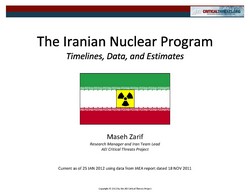{{currentView.title}}
January 31, 2012
The Iranian Nuclear Program: Timelines, Data, and Estimates V1.1
This assessment is version 1.1 of a recurring analysis of Iran’s nuclear program.
Iran is at the threshold of a nuclear weapons capability. Sanctions, direct action, and diplomatic tools have neither changed Iran’s nuclear policy nor had a visible effect on the enrichment program, including the growing stockpile of 19.75% LEU. Obtaining weapons-grade high-enriched uranium (HEU) is the most difficult and technically challenging obstacle to acquiring a nuclear weapon. Assessing the “breakout” time—the time required to convert low-enriched uranium (LEU) to weapons-grade HEU—is therefore a critical component of determining progress toward a nuclear weapons capability.
 |
AEI's Critical Threats Project has produced a capabilities-assessment of the time required for Iran to acquire enough weapons-grade uranium to fuel one nuclear weapon if it proceeds to break out in 2012. It does not assess Iran’s intentions to weaponize or to purse break-out scenarios, but rather focuses entirely on technical feasibility. The assessment also provides scenarios for the growth of Iran’s 19.75% LEU stockpile, background data on processes involved in a nuclear weapons program and Iran’s reported progress, and imagery of the primary enrichment facilities at Natanz and Fordow.
This product is an exposition of the technical data contained in numerous International Atomic Energy Agency (IAEA) reports informed by the discussions of experts in the field of nuclear proliferation. It is a work in progress in that it will be revised continuously based on new information from the IAEA reports and other sources and on feedback from readers. We welcome your informed commentary on the technical considerations presented in this document. Please send your comments, with references to source-date or documentation, to [email protected].
WORST-CASE SCENARIOS
Iran could acquire enough weapons-grade uranium for one weapon within one month of starting to race. This scenario is highly unlikely.
Assumptions:
- The worst-case scenarios assume that Iran devotes all operating centrifuges at Natanz to producing first 19.75% LEU and then 90% HEU, ceasing production of 3.5% LEU. Such actions would be visible to inspectors and so would most likely occur between inspections. Iranian nuclear policy and strategy does not appear to be going down this road.
- The scenarios assume 6,208 centrifuges spinning (the number being fed uranium as of November 18, 2011) operating with an efficiency of 0.9 separative work units (SWU)/centrifuge/year (roughly the efficiency they have demonstrated).
- Both worst-case scenarios assume that Iran begins to race to breakout on February 1, 2012.
- In the first case, producing 116kg of 19.75% LEU and then enriching directly to 90% HEU; in the second case, producing 243kg of 19.75% LEU, then enriching to 60% HEU and then to 90% HEU.
- These calculations assume tails assays of 2.0% and 9.3% for the two steps in the first process and 2.0%, 12.0%, and 41.1% for the three steps in the second process. These data are derived from the Natanz facility; the Fordow installations are notably more efficient with lower tails assays.
MOST LIKELY SCENARIOs
Iran can acquire weapons-grade uranium for one weapon by mid-August 2012 under currently-announced plans for expanding enrichment. This scenario is somewhat likely.
Iran will acquire enough 19.75% low-enriched uranium by June 1, 2012 to be within 2.5 months of producing weapons-grade uranium for one 15 kiloton bomb under certain contested technical assumptions. This scenario is the most likely.
Assumptions:
- The 6,208 centrifuges in the main cascade at Natanz continue to produce 3.5% LEU and are not diverted to higher-level enrichment.
- Enrichment to 19.75% occurs in four cascades totaling 676 IR-1 centrifuges (2 interconnected at the Natanz PFEP and 2 interconnected at Fordow).
- At least one additional cascade is brought online at Fordow by the end of March 2012, adding 164 IR-1 centrifuges.
- The scenarios also consider the possibility that Iran starts enriching with 1 cascade of IR-2 centrifuges (164 total) in June 2012 either at Natanz (where they are currently installed and under vacuum) or after moving them to Fordow. It adds another 2 cascades of IR-2 centrifuges (328 total) at Fordow in August 2012 and stops enriching at the 2 IR-1 cascades at the Natanz PFEP.
- Estimates for all three of these sub-scenarios are available on page 6 of the assessment.
- These calculations assume tails assays of 0.7% and 4.6% for the two steps. The difference in the tails between the scenarios reflects the fact that the cascades at PFEP and Fordow are interconnected.
Documentation of the sources and scenario assumptions is available in the full document.
Version History
January 31, 2012: Version 1.1 (with gratitude to Greg Jones, NPEC, for feedback)
- Clarified scenarios on p. 3.
- Previous version had erroneously noted that Hiroshima bomb had used 15 kg HEU; in fact, that gun-type device had used 50 kg HEU.
- Feedback noted that Iran is installing 2 interconnected cascades of IR-1 centrifuges at Fordow (174 each), where this assessment adds only one of 164 in March 2012. Iran is more likely to bring the centrifuges online in pairs, but we will await the next IAEA report to verify the status of the additional cascades and incorporate adjustments in the February assessment.
- Timeline start date on p.14 adjusted to 2/1/12 to match scenario assumptions.
- The time required for the final two steps of the three-step process at Natanz FEP in the Worst Case scenario was adjusted based on feedback noting that separative work calculators do not provide accurate calculations for assessing higher enrichment levels at the Natanz FEP.
- Estimates attributed to Greg Jones adjusted on timeline on p.14. Greg Jones's calculations indicate that Iran does not have enough 3.5% LEU now to complete a 3-step process to 90% at Natanz; the last tick on his estimate timeline was therefore removed because it is beyond the range of the timeline.
January 26, 2012: Version 1.0
- Release.
